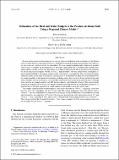Estimation of the Heat and Water Budgets of the Persian (Arabian) Gulf Using a Regional Climate Model
Author(s)
Xue, Pengfei; Eltahir, Elfatih A. B.
DownloadXue-2015-Estimation of the He.pdf (3.531Mb)
PUBLISHER_POLICY
Publisher Policy
Article is made available in accordance with the publisher's policy and may be subject to US copyright law. Please refer to the publisher's site for terms of use.
Terms of use
Metadata
Show full item recordAbstract
Because of the scarcity of observational data, existing estimates of the heat and water budgets of the Persian Gulf are rather uncertain. This uncertainty leaves open the fundamental question of whether this water body is a net heat source or a net heat sink to the atmosphere. Previous regional modeling studies either used specified surface fluxes to simulate the hydrodynamics of the Gulf or prescribed SST in simulating the regional atmospheric climate; neither of these two approaches is suitable for addressing the above question or for projecting the future climate in this region. For the first time, a high-resolution, two-way, coupled Gulf–atmosphere regional model (GARM) is developed, forced by solar radiation and constrained by observed lateral boundary conditions, suited for the study of current and future climates of the Persian Gulf. Here, this study demonstrates the unique capability of this model in consistently predicting surface heat and water fluxes and lateral heat and water exchanges with the Arabian Sea, as well as the variability of water temperature and water mass. Although these variables are strongly coupled, only SST has been directly and sufficiently observed. The coupled model succeeds in simulating the water and heat budgets of the Persian Gulf without any artificial flux adjustment, as demonstrated in the close agreement of model simulation with satellite and in situ observations.
The coupled regional climate model simulates a net surface heat flux of +3 W m[superscript −2], suggesting a small net heat flux from the atmosphere into the Persian Gulf. The annual evaporation from the Persian Gulf is 1.84 m yr[superscript −1], and the annual influx and outflux of water through the Strait of Hormuz between the Persian Gulf and Arabian Sea are equivalent to Persian Gulf–averaged precipitation and evaporation rates of 33.7 and 32.1 m yr[superscript −1], with a net influx of water equivalent to a Persian Gulf–averaged precipitation rate of 1.6 m yr[superscript −1]. The average depth of the Persian Gulf water is ~38 m. Hence, it suggests that the mean residency time scale for the entire Persian Gulf is ~14 months.
Date issued
2015-07Department
Massachusetts Institute of Technology. Department of Civil and Environmental EngineeringJournal
Journal of Climate
Publisher
American Meteorological Society
Citation
Xue, Pengfei, and Elfatih A. B. Eltahir. “Estimation of the Heat and Water Budgets of the Persian (Arabian) Gulf Using a Regional Climate Model.” J. Climate 28, no. 13 (July 2015): 5041–5062. © 2015 American Meteorological Society
Version: Final published version
ISSN
0894-8755
1520-0442